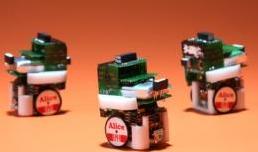Can robots with ‘altruism genes’ evolve?
May 4, 2011

Small foraging robots evolved cooperative behavior over many generations (Credit: EPFL/Alain Herzog)
Foraging robots that are evolved over many generations start to show altruistic, cooperative behavior when given the choice to share seed-like objects, researchers at École Polytechnique Fédérale de Lausanne (EPFL) and the University of Lausanne have found.
The foraging robots were designed to perform simple tasks, such as pushing seed-like objects across the floor to a destination, and evolved over many generations.
Those robots not able to push the seeds to the correct location were selected out and could not pass on their code. The robots that performed comparatively better saw their code reproduced, mutated, and recombined with that of other robots into the next generation. This provides a minimal, simulated model of natural selection, the researchers said.
The researchers decided to test “Hamiliton’s rule” (developed by biologist W.D. Hamilton in 1964): if an individual family member shares food with the rest of the family, it reduces his or her personal likelihood of survival but increases the chances of family members passing on their genes, many of which are common to the entire family. Whether or not an organism shares its food with another depends on its genetic closeness (how many genes it shares) with the other organism.
The researchers modified the foraging algorithm so that once a foraging robot pushes a seed to the proper destination, it can decide whether it wants to share it or not. Evolutionary experiments lasting 500 generations were repeated for several scenarios of altruistic interaction. The experiments included how much is shared and at what cost for the individual, as well as studies of genetic relatedness in the population. The researchers created groups of relatedness that, in the robot world, would be the equivalent of complete clones, siblings, cousins, and non-relatives.
They found that groups that shared along the lines of Hamilton’s rule (sharing the seed-like objects with the rest of their “family”) foraged better and passed their code onto the next generation.
Hamilton’s original theory takes a limited and isolated vision of gene interaction into account, whereas the genetic simulations run in the foraging robots integrate effects of one gene on multiple other genes with Hamilton’s rule still holding true.
The findings are already proving useful in swarm robotics, the researchers said. “We have been able to take this experiment and extract an algorithm that we can use to evolve cooperation in any type of robot.”
Ref.: Waibel M, Floreano D, Keller L (2011) A Quantitative Test of Hamilton’s Rule for the Evolution of Altruism. PLoS Biol 9(5): e1000615. doi:10.1371/journal.pbio.1000615 (open access)